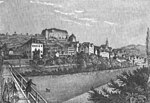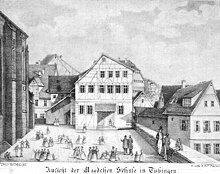Carl Baumann (photographer)
Carl Friedrich Baumann (born January 13, 1798 in Tübingen ; † March 14, 1878 there ) was a Württemberg draftsman and lithographer in Tübingen. From 1855 to 1865 he worked as a photographer . He was the father of Carl Immanuel Baumann (also called Carl Baumann jun. ) And Hermann Baumann .
Life
Youth and drawing activity
Carl Friedrich Baumann was a son of Wilhelm Gottlieb Baumann (1756–1831). Originally, like his father, he was trained as a locksmith. Although there is evidence that he was born in Tübingen, Baumann signed some of his pictures as "Baumann from Mergentheim ", which is interpreted as an indication that he spent his youth in Mergentheim.
He enjoyed his training as a draftsman and lithographer with Ludwig August Helvig in Tübingen. By 1829 at the latest he had a lithographic establishment in Tübingen. In 1831 he married Johanna Catharina Carolina Seiter (1811-1896) from Ludwigsburg . He had nine children with her. When he married, Baumann was registered as a painter and lithographer. He produced all kinds of printed matter. In 1837 he became a drawing teacher at the secondary school in Tübingen. He continued to operate his institution and, for example, around 1840 he illustrated the "Petrification Studies of Germany" by Friedrich August von Quenstedt . Medical abnormalities were also illustrated by him as student visual aids.
Baumann's Tübingen views document the structural development of the city as well as its economic, cultural and political life. Far more cityscapes exist of him than of his teacher Helvig. Like Helvig, Baumann lithographed the city gates shortly before they were demolished (1829). He preferred the general view of the city from the Österberg as well as motifs in the city such as the new university buildings. Baumann shows the peaceful bathers on the "Neckarstrand" as well as the leaders of the student security guard, who opposed the rebellious winegrowers and craftsmen of the lower town in 1831, or the storming of the Schweickhardtsche Kunstmühle in 1847.
Until significantly new conditions arose in the picture market due to social changes and technical possibilities, the picture formulations used in portraits and landscapes continued to apply unchanged for him (as well as for Jacob Kull ): Half-length portraits that were fully focused on the carefully worked out face, sitting half-figures in the extensive iconography of the scholarly portraits, exceptionally also full figures, as well as the vedute of the beginning of the 19th century: views of the city, buildings of the university and places of student life.
Baumann's lithographic workshop was taken over by his son Hermann, who often copied his father.
Inauguration of the new auditorium on October 31, 1845 (lithograph)
Impaler and Baumann
In 1853 Baumann lost his position as a drawing teacher, which he had had for 16 years. He was forced to look around for new additional income and became the Schrannenmeister of the municipal granary . This activity was probably just a stopgap solution for him.
He strove to do something that tied in with his actual job and came to an understanding with the much younger Stuttgart photographer Rudolf Pfähler . The two began their photographic collaboration in Tübingen in 1855. They didn't have a studio, they just took photos outside, labeled “R. Pfähler and C. Baumann in Tübingen ”. It is not known how the relations between the two partners were regulated. The collaboration did not last long, Pfähler probably returned to Stuttgart in the course of 1856, where he was definitely active as a photographer from 1857 onwards. The quality of the surviving photos of Baumann from the first time after Pfähler's departure was significantly worse than in the beginning, so it can be assumed that Baumann learned the photographic trade from Pfähler and did not yet master it properly at the time of the separation.
"Baumann & Son"
Baumann “lived in Haaggasse and took pictures in the Höfle behind the house with a rather primitive presentation. The customer usually sat on a simple wooden chair with his arm resting on a small round table ”.
After Pfähler left, his son Carl Immanuel Baumann worked with Baumann . During this time the photos were marked with “C. Baumann ”,“ Photography by Baumann, Tübingen ”or“ Photography by Baumann & Sohn ”. The collaboration between father and son lasted until December 1859, when he moved to the Engel and started his own business.
Although physically separated, father and son remained in close contact. They were the only photographers invited to take part in a trade exhibition in the greenhouses of the Botanical Garden on the occasion of King Karl's homage trip in the summer of 1865. There was no lasting success: the son's studio was auctioned off in the spring of 1866 together with two "photographic apparatus" - one of which was apparently from the father's possession. After that, the two Baumanns are only mentioned as lithographers.
Although Baumann did not own any real estate, he was able to pay his taxes until his death at the age of 80 and left a small inheritance.
R. Pfähler & C. Baumann: Portrait of Wilhelm (von) Hertz
R. Pfähler & C. Baumann: New auditorium
Well-known work
Vedute
All, unless otherwise stated, City Museum Tübingen
- 1824 Sophien-Pflege zu Lustnau (drawing, handed down as a chalk lithograph by Jacob Kull )
- approx. 1825 Schmiedtor ( gouache , 200 × 160 mm)
- approx. 1825 Haagtor (gouache, 200 × 160 mm)
- ca.1825 Lustnauer Tor (copy after LA Helvig) (gouache, 160 × 225 mm)
- 1828 Tübingen from the morning side (from the foot of the Österberg ) (lithograph, 290 × 433 mm)
- 1830 Hirschgasse (gouache, 110 × 150 mm)
- approx. 1830 Tübingen from the evening side (lithograph, 88 × 125 mm)
- approx. 1830 Neckarvorstadt (pen drawing with watercolors, 245 × 95 mm)
- ca.1830 Die alte Eifertei (lithograph, 120 × 138 mm)
- 1831 Landjäger am Drecktörle (India ink drawing 193 × 248 mm)
- 1835 "The Neckar Bridge to Tübingen" (Indian ink and color on paper)
- approx. 1835 Tübingen from the southwest side (lithograph, 496 × 449 mm)
- ca.1840 Tübingen from the east (steel engraving, 183 × 246 mm; printed by Ernst Friedrich Grünewald in Darmstadt , Verlag L. Fues in Tübingen)
- approx. 1840 Tübingen from the west (steel engraving, 182 × 242 mm)
- approx. 1840 Tübingen vom Frondsberg (lithograph, 160 × 225 mm)
- approx. 1840 Marktplatz (lithograph, 162 × 225 mm)
- ca.1840 girls' school on the church square (lithograph, 116 × 160 mm)
- 1845 For the inauguration of the New Aula on October 31, 1845 (lithograph, 217 × 314 mm)
- 1847 Storming of the Schweickhardt'sche Kunstmühle (lithograph, 160 × 223 mm)
- approx. 1850 Tübingen from the east towards Reutlinger Strasse (lithograph, 160 × 225 mm)
- approx. 1850 Tübingen from the southwest side with Hirschauer Steg (lithograph, 153 × 230 mm)
- approx. 1850 Evangelical pen (lithograph, 160 × 223 mm)
- approx. 1850 Neue Aula (lithograph, 160 × 225 mm; Württemberg State Library Stuttgart)
- approx. 1850 Schloßküferei (Indian ink over pencil, 240 × 215 mm)
Photographic work
- 1855 Portrait of Wilhelm (von) Hertz (180 × 141 mm; Schiller National Museum Marbach )
- 1855 New Aula (143 × 182 mm; first photo of the New Aula, Corps Suevia Archive ). Especially when you compare the photo with Baumann's lithograph of the inauguration of the New Aula in 1845, it becomes clear that it breaks with the earlier tradition and suppresses the castle-like character of the building.
- around 1860 Portrait of a stranger (colored salt paper print, 88 × 71 mm; Tübingen City Archives, photo collection 5996)
- around 1860 Three men (Bruckmann, Riss and a stranger), (photo montage, album print, 124 × 102 mm; Tübingen city archive, photo collection 12145)
Notes and individual references
- ↑ Christina Melk: Tübingen views and painters in the 19th century , p. 37, or cityscape - world view. Tübingen city views from the 16th to the 19th century , Tübingen 2009, p. 231
- ↑ Apart from the sons Carl Immanuel and Hermann mentioned in this article, another son was a lithographer in Cannstatt . Three of Baumann's daughters emigrated to America.
- ↑ a b c d Christina Melk: Tübingen Views and Painters in the 19th Century , p. 37
- ↑ Wolfgang Hesse: Views from Swabia ... , p. 8
- ↑ Wolfgang Hesse: Views from Swabia ... , p. 30 with reference to "Tübinger Chronik" from October 29, 1853 and February 5, 1854
- ↑ a b Wolfgang Hesse: Views from Swabia ... , p. 29
- ↑ Wolfgang Hesse: Views from Swabia ... , p. 29 quoted: Mathilde Sinner: The Tübingen photographer Paul Sinner as a photo reporter in the Seventy War , in: "Tübinger Chronik", December 24, 1942
- ↑ Wolfgang Hesse: Views from Swabia ... , p. 30 quotes the son's advertisement from the "Tübinger Chronik" of December 7th and 12th, 1859.
- ↑ Wolfgang Hesse: Views from Swabia ... , p. 35
- ↑ Wolfgang Hesse: Views from Schwaben ... , p. 31 quotes the announcement of the auction from the "Tübinger Chronik" of February 6th and March 10th and 13th, 1866
bibliography
- Wolfgang Hesse: Views from Swabia. Art, country and people in photos by the first Tübingen photographers and the photographer Paul Sinner (1838–1925) , Metz brothers : Tübingen 1989, ISBN 3-921580-79-X
- Christina Melk: Tübingen Views and Painters in the 19th Century , Tübingen 1986 (= Tübingen Catalogs No. 27)
Web links
| personal data | |
|---|---|
| SURNAME | Baumann, Carl |
| ALTERNATIVE NAMES | Baumann, Carl Friedrich |
| BRIEF DESCRIPTION | Wuerttemberg draftsman, lithographer and photographer |
| DATE OF BIRTH | January 13, 1798 |
| PLACE OF BIRTH | Tübingen |
| DATE OF DEATH | March 14, 1878 |
| Place of death | Tübingen |













